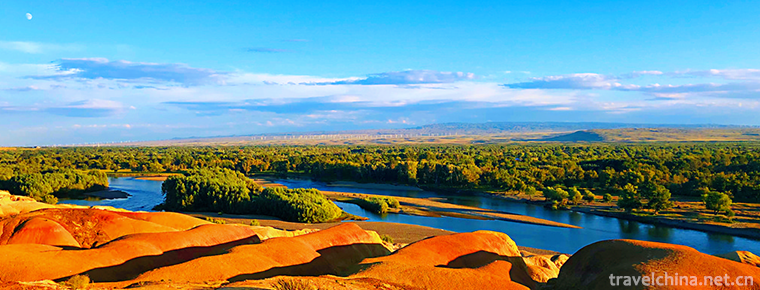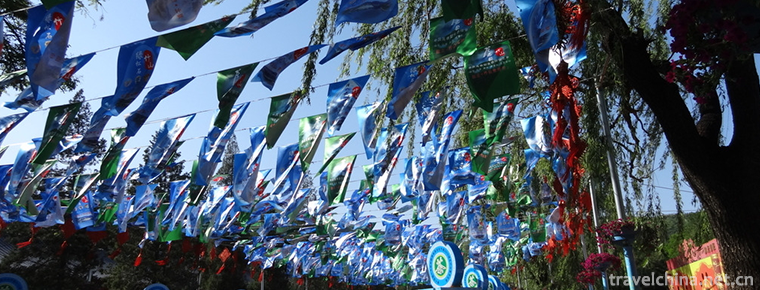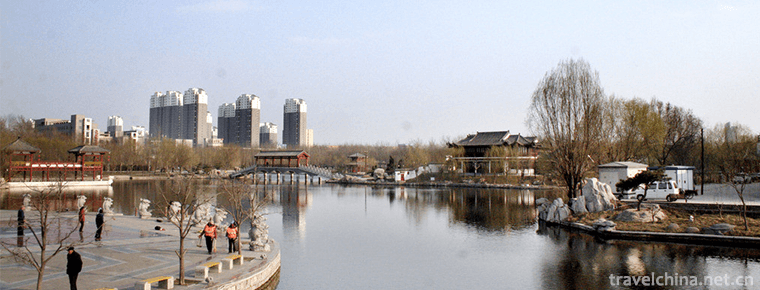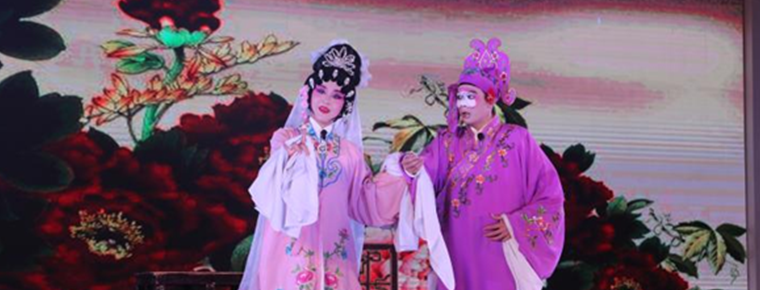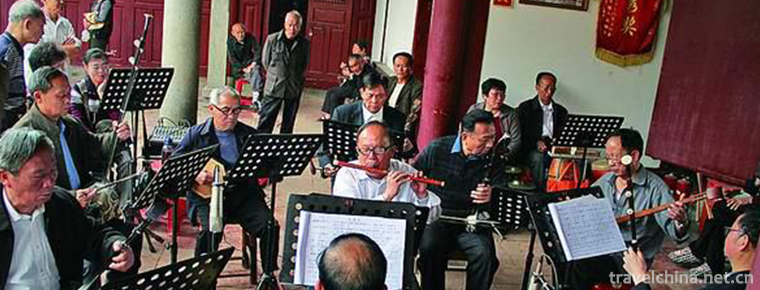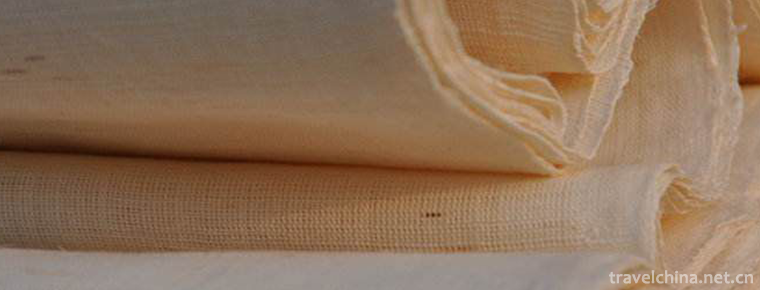Legend of Cowherd and Weaver Girl
Legend of Cowherd and Weaver Girl
Niulang and Zhinu are one of the four Chinese folk love legends (the other three are Legends of White Snake, Meng Jiangnu Crying Great Wall, Liang Shanbo and Zhu Yingtai). They derive from the star names of Altair and Vega. The Festival related to this legend is Qixi Festival.
In 2008, the legend of Cowherd and Weaver Girl was listed in the second batch of national intangible cultural heritage list with the approval of the State Council.
Myths and legends
There is a Vega and an Altair in the sky. Zhinu and Morning Glory have the same feelings and hearts. However, the law of heaven does not allow men to love women and love themselves. The Weaver Maid is the granddaughter of the Queen Mother. The Queen Mother demoted the morning glory to the earth and made the Weaver Maid weave the cloud brocade continuously as punishment. The weaver's job is to use a magical silk on the loom to weave layers of beautiful clouds, changing their colors with time and season, which is the "sky coat". Ever since morning glory was demoted, Zhinu often washed her face with tears and missed morning gloomy. She sat beside the loom, weaving beautiful brocade of clouds, hoping to win the kindness of the Queen Mother and let morning glory return to the heavens as soon as possible. One day, several fairies begged the Queen Mother to go for a visit to the Bilian Pool on earth. The Queen Mother was in a good mood today, so she promised them. When they saw that Zhinu was depressed all day long, they prayed to the Queen Mother to let her go together. The Queen Mother was also distressed by her punished granddaughter, so that they could go back quickly. After morning glory was demoted, it was born in a farmer's home, named Niulang. Later, when his parents died, he lived with his brother and sister-in-law. Brother's sister-in-law treated Niulang very harshly, and wanted to separate from him, only gave him an old cow, called Niulang self-supporting portal.
From then on, the Cowherd and the old cow depended on each other. They cut thorns in the wasteland, ploughed the fields and built houses. A year or two later, they built a small home, barely able to live. However, apart from the silent old cow, the lonely family only had a cowherd, and the life was quite lonely. Cowherd did not know that the old cow was originally Taurus in the sky. On this day, the old cow suddenly opened his mouth and said to the cowherd, "Cowherd, you go to Bilian Pool today. There are some fairies taking a bath. You hide the Red Fairy clothes and the fairy in the Red Fairy clothes will become your wife." When Niu Lang saw Lao Niu's mouth spitting, he was surprised and happy. He asked, "Big Brother Niu, do you really speak?" Are you telling the truth? The old cow nodded, and the cowherd quietly hid in the reed beside the Bilian Pond, waiting for the fairies to come. In a short time, the fairies did indeed float to, take off their light clothes and jump into the clear stream. Niulang ran out of the reed and took away the Red Fairy clothes. When the fairies saw someone coming, they put on their clothes in a hurry and flew away like birds, leaving only fairies who could not escape without clothes. She was the weaver girl. The Weaver Maid saw her fairy clothes robbed by a young man. She was shy and anxious, but she was helpless. At this time, Niulang came up and said to her that he could only give back her clothes if she promised to be his wife. The Weaver Girl looked closely and realized that the Cowherd was the morning glory she was thinking about day and night, so she shyly promised him. In this way, Zhinu became the wife of Cowherd. After they got married, men farmed and women weaved. They loved each other and lived happily. Soon after, they gave birth to a son and a daughter, very lovely. Cowherd and Weaver Girl thought they could stay together forever.
However, when the Queen Mother knew about it, she was furious and sent the fairy to catch the Weaver Maiden and ask her guilt in heaven. On this day, Zhinu was cooking. The cowherd who went down rushed back, his eyes were red and swollen, and told Zhinu, "Big Brother Niu is dead. Before he died, he said that he wanted me to peel off his cowhide after his death. One day, he would put it on and fly to the sky." When Vega listened, she was puzzled. She knew that the old bull was the Taurus in the sky. She only said a few fair words for the demoted morning glory, but also demoted to heaven. How could it suddenly die? The Weaver Girl let the Cowherd peel off the cowhide and bury the old cow well. At that moment, the sky was windy, and the Heavenly Soldier would descend from the sky. It could not be said that Zhinu flew up into the sky with her. Flying, flying, Zhinu heard the voice of the Cowherd: "Zhinu, wait for me!" The Weaver Girl looked back and saw the Cowherd come with two children in a pair of baskets and cowhide. Slowly, the distance between them is getting closer and closer. Zhinu can see the lovely appearance of her children. The children all open their arms and shout "Mom" loudly. Seeing, the Cowherd and Zhinu are about to meet. But just then, the Queen Mother arrived in Xiangyun. She pulled out the golden hairpin on her head and drew a stroke between them. Suddenly, a heavenly river rolled between Zhinu and Niulang, which could not be crossed.
The weaver girl looked at the cowboys and their children on the other side of the Tianhe River. She cried so loudly that the cowboys and their children cried to death. Their cries and the children's cries of "mother" are so heartbreaking and tearing that even the fairies and gods who are watching feel sad and distressed. When the Queen Mother saw this and was slightly touched by the steadfast love between Cowherd and Weaver Nun, she agreed to let Cowherd and the children stay in the sky and meet once a year on July 7. Since then, Niulang and his sons and daughters have lived in the sky, across a Tianhe River, and far away from Zhinu. Among the stars in the autumn sky, we can still see two larger stars on both sides of the Milky Way, glittering sparkly, that is, Vega and Altair. There are also two little stars with Altair, the son and daughter of Cowherd and Weaver Girl. On July 7th, when Cowherd and Weaver Girl met, numerous groups of magpies flew to build bridges for them. Over the Magpie Bridge, Cowherd and Weaver Girl are reunited! Weaver girl and cowherd love each other, embracing their children, there are countless words to say, there are endless feelings to talk about ah! Legend has it that on July 7th of every year, if people listen quietly in the grape vines under the vines, they can hear the immortal music sounding, and the Weaver Girl and the Cowherd are talking deeply. Really: It's hard to be apart and hard to meet. They are looking forward to their reunion on July 7, the next year.
According to the records of ancient books, people think that Zhinu is smart, beautiful and versatile. In the evening of July 7th, they beg Zhinu for wisdom, which can remove clumsiness and become smart, so it is also called "Qiaoqiao Festival". Because most of the women who participate in Qiao activities are boudoir women, it is also called "Daughter's Day". Most Japanese women gather in the courtyard, wearing new clothes, worshipping double stars (i.e. Cowherd and Vega), arranging incense cases, offering fruit, threading needles and threads, lapping colorful thread, and carrying out various begging activities.
Relevant Folklore
Qiqiao
On the seventh night of the meeting of Cowherd and Weaver Girl, women also beg for wisdom from Weaver Girl. As recorded in Jingchu Sui Shi Ji, the begging method in the Southern and Southern Dynasties was "colorful thread piercing seven-hole needle". Women used silk thread to pierce needles back and forth, so it was natural coincidence to wear them fast. After the Ming and Qing Dynasties, the game of "throwing a clever needle" became more popular. The method is to take a bowl of water and expose it to the sun on the morning of July 7. Immediately after that, a film will be formed on the surface of the water. At this time, the needle for sewing or embroidery is thrown into the bowl. If the needle floats on the water, it is a coincidence.
July 7th Water
Legend has it that the seventh day of the seventh lunar month is the day when the Cowherd and the Weaver Girl meet each other. It often rains on this day, and these rains are the tears that the old people often say when the Cowherd and the Weaver Girl meet. On this day, people will put the jar that can hold rainwater in their homes in the yard, or put it outside the balcony of the open air to receive the rainwater, because it is said that these rains can do it. Another way of saying is to use a deeper tile or porcelain jar to catch rainwater, then buy a winter melon suitable for the size of the jar and stuff it into the jar, then seal the mouth of the jar, and then store the jar in a shady place in the room. After a few days, it opens, and it becomes a jar of July and July melon juice. According to legend, this kind of July and July water drinks. In summer, children with prickles can also use these winter melon water to stick on the pearl powder to smear prickles, which has a good effect.
Current situation of inheritance
Inner Hill of Hebei Province
Over 400 Years of History Inheritance of "Qixi" Ten Thousands of People Sacrificing Cowherd and Weaver Girl
"July comes to July 7, when the Cowherd and the Weaver Girl meet. Immortals love each other, love and love husband and wife..." On the day of July Festival on the 20th, Yuhuang Temple in Dongguan, Neiqiu County, Hebei Province, was very busy.
On the one hand, dense crowds surrounded by colorful "canopy and canopy", marching at rhythmic steps, singing songs compiled by themselves, expressing the hope of reunion of Cowherd and Weaver Girl. On the other side of the stage, classical love operas such as Tianhe Pair, The Story of the Western Chamber and The Pair of Firearms were staged in turn, attracting thousands of people to stop and watch.
According to the chairman of Neiqiu Wenlian and Lian Fen, the Temple Fair in Neiqiu County on July 7 was set up to offer sacrifices to Niulang and Zhinu Queqiao. There is no way to verify the date of its establishment. Among them, the canopy began in the Ming Dynasty (1567-1572).
Every year from the first to the seventh day of the seventh lunar month, tens of thousands of people from surrounding counties and cities such as Xingtai, Longyao and Lincheng in Hebei Province and even from Shanxi and Shaanxi provinces pour into Neiqiu County Town from all sides, gathering at the Jade Emperor's Temple on Dongjie, and meeting at Niulang Zhinu Queqiao Bridge through ceremonies such as offering sacrifices, doing meritorious deeds and worshiping canopies, day and night, in order to pray for a happy marriage and family.
In the central area in front of the Jade Emperor's Palace, people surrounded and worshipped two colorful paper-cuts about 4 meters square: the sun, moon, galaxy, magpie bridge, cowherd, weaver girl, flowers, birds, fish, insects and other colorful paper-cut patterns. This unique form of sacrificial ceremony is "worship the ceiling, the canopy".
This is an important part of the sacrificial activities. The whole picture does not contain half a sentence of words. It does not need pen and ink to sketch. It is completely completed with paper-cut scissors. It uses paper-cut art to show the magpie bridge meeting of Cowherd and Weaver Girl.
Fan Baoxiu, the producer of this year's ceiling and canopy, said, "This kind of production craft was handed down during the Longqing period of the Ming Dynasty. It has been handed down from generation to generation and has been handed down to the present day. Teachers teach, women do not pass on to men, and outside does not pass on to the inside. Through competition, it is necessary to determine the recognized two skilled and skilled people who undertake the mission of making ceiling and floor canopy. When making, the producer should clean his body, hands, face and mouth, wear neat clothes, and then cut the pattern.
Liu Kuili, member of the Honorary Department of the Chinese Academy of Social Sciences and President of the Chinese Folklore Society, visited the Temple Fair on July 7 twice. He believed that the paper-cut of the ceiling and the canopy was not only a simple aesthetic creation, but also a record of folk astronomical knowledge and an image of the people's world outlook and world outlook.
Special stamps
Interpretation of love stories between cubic inches, Cowherd and Weaver Girl boarded the national business card. On the day of July Festival on August 16, 2010, China issued a set of four special stamps for the first time, namely "Folk Legend - Cowherd and Weaver Girl", in order to promote the ancient and faithful concept of love embodied in the Qixi culture in the form of stamps. In order to make this set of stamps full of Qixi culture, the first issue of the stamp "Legend of the Cowherd and Weaver Girl" and the Qixi Love Festival, the hometown of Chinese Cowherd and Weaver Girl Culture, was held in Lushan County on the morning of 16th, and issued simultaneously at relevant post outlets throughout the country. Four stamps are "robbing clothes and getting married", "farming women and weaving men", "pursuing wives with burdens" and "meeting magpie bridges". These stamps are linked together to tell a sad love story about the "silly man" Niulang and the "grumbling girl" Zhinu. Local postal departments have also launched three scenic postmarks and the first commemorative postmark, such as "Niulang Cave", "Zhinutan" and "Sun's ancestral hall", in order to attract more people. Focusers. At the same time, the "Qixi Festival" collective wedding ceremony, attended by couples aligned with Lushan 77, is regarded as a commemoration of the traditional Qixi Festival.
Inheritance Significance
The legend of "Cowherd and Weaver Girl" originated and formed in Lushan. The local culture of "Cowherd and Weaver Girl" retained its original features. The earliest topographical records of Jiajing in Ming Dynasty and of cities, counties and townships are recorded. Lufeng Mountain in Lushan has a unique peak, which is traditionally herded by Niulang. It is the first of the eight ancient sceneries of Lushan Mountain. The Niulang Cave under the mountain is where Niulang meets Zhinu. The descendants of Niulang often kneel in front of Niulang Cave to worship and worship their ancestors. Beggars in Nine Women's Temple, Qixi Festival's begging custom, eavesdropping custom under the grape shelf, Qixi ancient temple fair in Xinji Township, Lushan County, sericulture and silk weaving in mountain areas, farmers'respect for cattle, and the sharp contrast between the prohibition of Tianhe Ji in Sun Yi Village, the hometown of Niulang and the biography of Niulang Zhinu Opera in other villages, all show the profound cultural foundation of Niulang Zhinu story in Lushan County, and the people of Lushan Mountain. For thousands of years, people have firmly believed that this is a true and beautiful story, "Lushan Hillside on the ground, Milky Way in the sky, Niu Nu meets each other, and there is much happiness in the world." They have sung thousands of years of folk songs about Niu Lang and Zhinu, and retained the original folk culture, and added their respect and remembrance for this love story.
In August 2008, the Chinese Association of Folk Literary Artists organized a group of experts to go to Xinji Township, Lushan County, and on-the-spot inspected the Niulang and Zhinu sites such as Sun's Temple, Niulangdong and Jiunutan. On February 18, 2009, the CPPCA officially named Lushan County as "the hometown of Chinese Niulang and Zhinu culture".
Literary Interpretation
Chinese experts interpret the details of the legend of Cowherd and Weaver Girl in the seventh day of the seventh month of the seventh lunar month, which is not different from other days. But because of the story of Cowherd and Weaver Girl, this day has become a "sentimental" day for Chinese people. "There is a man in the Uygur Empire and a light in the prison. The Weaver Girl, Seven Xiangs a Day. Although it is seven xiang, it is not a newspaper. The petunias are not allowed to serve in boxes." The record of Vega and Altair stars in The Book of Songs Xiaoya Dadong is regarded by experts as the germination and embryo of the legend of Cowherd and Vega.
Some people think that the legend of Niulang and Zhinu was formed in the Western Zhou Dynasty, the Western Han Dynasty and the late Eastern Han Dynasty. Liu Kuili, president of the Chinese Folklore Society, said: "It can not be said that there must be no such story in the period of the Book of Songs, but it is certain that the legend of Cowherd and Weaver Girl will not come into being later than the Eastern Han Dynasty." It is understood that the ancients first had the name of the stars, then there were myths, and then evolved into legends. According to astronomers'estimates, the seventh month of the lunar calendar is the turn of summer and autumn. Vega rises to the highest point of the year and shines brightly in the night sky. At this time, the weather begins to cool, and women are busy spinning and weaving clothes to prepare cold clothes. On quiet nights, the woman worked beside the loom, and the bright star she saw was named Vega.
Experts believe that the name of Altair is due to sacrifice. In August, when the animals were fat and strong, the ancients began to choose sacrificial livestock. At this time, Vega, once high above the zenith, tilted westward, and Altair rose to the top, hence the name "Altair". At the turn of autumn, Vega and Altair rose to the heavens one after another, separated on both sides of the Milky Way, and looked at each other from afar, thus the love story of the star God of Altair Vega came into being. In the Han Dynasty, through continuous creation, this star myth gradually evolved into the legend of "love between man and immortal". He Xuejun, deputy director of the Chinese Folklore Society, said that the legend of Cowherd and Weaver Girl has formed many versions in circulation, but there are several key plots that are basically the same: the Weaver Girl goes down to bathe, the Cowherd takes away the clothes of the Weaver Girl, the Cowherd and Weaver Girl get married, the Weaver Girl is captured back to Tianting, the Cowherd carries a pair of children to catch up, the Queen Mother rows the Tianhe River, bridging on July Evening, and listening to whispers under the 。
Li Wanpeng, a professor at Shandong University's College of Literature, believes that the often confused story of Dong Yong and the seven fairies "Tianxian Pair" takes shape later than the legend of Niulang and Zhinu "Tianhe Pair". The two stories have different social psychology. The story of "Tianxian Pair" advocates filial piety and emerges under the background of "filial piety governing the world" in the Han Dynasty, while the theme of the story of "Tianhe Pair" is family and marriage. It places people's expectations on the family of Hemei.
It is generally believed that magpies fly to heaven on the seventh day of July every year to build bridges for Cowherd and Weaver Girl. Experts have suggested that, in fact, in early legends, crows built bridges for them. Xuan Bingshan, an associate professor of Zhejiang Normal University, believes that the legend of Niulang and Zhinu originated in the north and gradually spread to the south. In the process of spreading south, the crow that built the bridge became a magpie. It is reported that in the north before the Song Dynasty, crows had three sacred identities: the symbol of the sun god in natural mythology; the symbol of the unity of the world in political mythology; and the symbol of filial piety in ethical mythology.
In Song Dynasty, northerners always thought crows were filial piety birds and righteous birds, so in northerners'view, the bridge was not magpies, but crows; while southerners liked magpies, when the north and South cultures merged, crows and magpies mixed together to build bridges, collectively known as "magpie bridge". Since the Tang and Song Dynasties, the North has declined and the economic and cultural centers have moved southward. Southerners gradually spread the idea of crow as a funeral bird to the north, crow withdraw from the ranks of bridging Cowherd and Weaver Girl, Qixi bridging became magpie's exclusive.
Summary of Legend
Niulang is an orphan in Niujiazhuang, living in his sister-in-law. His sister-in-law, Ma Shi, was so mean that he often abused him that he was forced to separate and feed himself on an old cow. The old cow is very clever. One day, the weaver girl and the fairies went to play and bathed in the river. The old cow advised the cowherd to take the clothes of the weaver girl, and the weaver girl became the wife of the cowherd. After marriage, they farmed and woven, and gave birth to a son and a daughter. Their life was very happy. Unexpectedly, the Emperor of Heaven found out the matter and sent the Queen Mother to escort the Zhinu back to heaven for trial. Lao Niu couldn't bear the separation of their wives, so he broke the horns on his head and turned into a boat, letting the Cowherd chase his children by boat. Seeing that she was about to catch up with Zhinu, the Queen Mother suddenly pulled out the gold hairpin on her head and drew a galaxy rolling in the sky. Niulang could not cross the river, but watched and wept with Zhinu by the river. Their steadfast love moved magpies. Countless magpies flew to build a colorful bridge across the Tianhe River with their bodies, so that Cowherd and Weaver Girl could meet on the Tianhe River. The Queen Mother had no choice but to allow Cowherd and Weaver Girl to meet on Magpie Bridge once a year on July 7.
Because the seventh day of July in the lunar calendar is in the rainy season, it often rains on that day. People say it is the tears of Cowherd and Weaver Girl. Some young boys and girls in the countryside will lie under the grape rack. It is said that they can hear the whispers of Cowherd and Weaver Girl. Because the story of Cowherd and Weaver Girl is beautiful and moving, people still use "Cowherd and Weaver Girl" to describe the love between husband and wife.
As for why the morning glory and the weaver girl had to wait for a while on July 7? The original text has not been explained. According to the speculation of later generations, on the one hand, the stars at night in July are the brightest in the sky, and the two stars of morning glory and Vega are close to each other. On the other hand, July 7th was the day of "Qiqiao" in the folk custom at that time, and the ancient Chinese working people regarded the Vega as a skilled worker, so they could weave hundreds of beauties in ten days. He begged her for cleverness. Thus, people combined the story of Cowherd and Weaver Girl with folk customs. With the passage of time, the story continues to enrich and develop. In Jingchu Sui Shi Ji, there is such a passage: "Weaver girl is in the east of Tianhe River, and the son of Emperor Tiandi is also weaving brocade Tianyi year by year through labor. The Emperor of Heaven mourned his solitude, and Xu Pai Hexi morning herd married and then abandoned weaving jackets. The Emperor of Heaven was angry and ordered to return to Hedong only once a year on July 7th. The story of Cowherd and Weaver Girl has changed greatly since then. Because the Cowherd and Weaver Girl were greedy for pleasure after marriage, they "scrapped the Weaving Coat", which angered the Emperor of Heaven and was punished. This brings tragic atmosphere to the story. In addition, there are two legends. First, Zhinu is the seventh (or ninth) granddaughter of the Emperor of Heaven. She weaves a brocade of clouds on the east side of the Tianhe River, while Niulang watches cattle on the west side of the Tianhe River. Both of them are diligent. The Emperor of Heaven loved them and made them marry. After marriage, they are greedy for pleasure and waste their labour. The Emperor of Heaven was angry and separated them. He ordered the crows to go and tell them to meet once in seven days. The crow, however, made a mistake, saying that he would meet once a year on July 7. Second, Zhinu is the granddaughter of the Queen Mother, weaving clouds in the sky. Niulang is a man who watches Niulang and is abused by his brother and sister-in-law. One day, the cow told him that Zhinu wanted to take a bath with other fairies in the Milky Way. She asked the cow to take a fairy dress. When Zhinu looked for clothes, she would give it back to her and ask her to marry her. She would certainly agree. The cowherd did the same. When Zhinu and Niulang got married, they gave birth to a man and a woman. When the Queen Mother knew this, she took Zhinu back. The cow told the cowherd that he could put his skin on his body and chase him up to heaven. When Niulang picked up two children and chased them up to heaven, the Queen Mother pulled out her hairpin and drew a line behind the Weaver Maid to form a Tianhe River, separating the loving couple. They wanted to see and cry every day across the river. They moved the Queen Mother and allowed them to meet once a year on July 7. When they meet, magpies build bridges for them. The basic plot in the former legend is similar to that in Jingchu Sui Shi Ji, but it only adds the plot of "Crow Legend". The latter kind of legend has greatly enriched and developed the original story. It transforms from the love of gods among stars into the love story between gods and men. As for other legends, most of them are based on this. So, why in the latter legend, add the role of Lao Niu and make it play a great role in the story? Because cattle are farm treasures, farmers love to farm cattle, and even put their ideal of life on farming cattle. When the ideal of life is hindered, farmers are apt to have the illusion of rescuing cattle. They hope that cattle can exert their magical power to help themselves overcome difficulties. At the same time, the personification of animals is also one of the artistic techniques often used in various folklores.

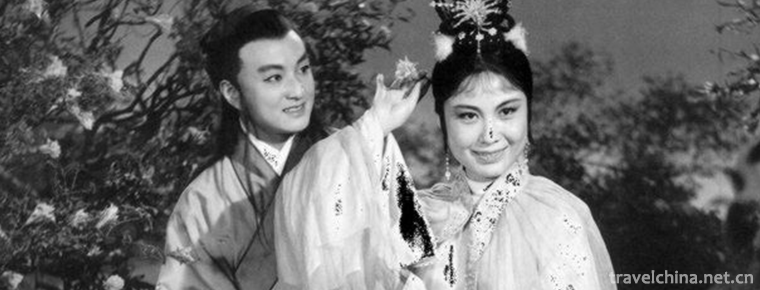
-
Wucai Beach
The Wucai Beach is located in Buerjin County, Altay area, north end of Xinjiang. It is located on the first and second terraces on the North Bank of Ertiz River, the only one injected into the Arctic .
Views: 101 Time 2018-12-22 -
Badachu Park
Located at the south foot of Beijing's famous Xishan scenic spot, Badadu Park is a national AAAA-level scenic spot. It is the first batch of key cultural relics protection units in Beijing after the f.
Views: 116 Time 2018-12-24 -
Dong Ziyuan Scenic Area
Dong Ziyuan Scenic Area belongs to Dezhou Economic Development Zone. Dezhou Economic Development Zone, as a provincial economic development zone approved by Shandong Provincial People's.
Views: 319 Time 2019-01-08 -
Niangziguan Scenic Area
Niangziguan is a famous pass of the Great Wall of China, known as the Ninth Pass of the Great Wall of China, and it is a must for military strategists of all dynasties..
Views: 224 Time 2019-02-07 -
Hua Chao Opera
Huachao Opera, a local traditional drama in Zijin County, Guangdong Province, is one of the national intangible cultural heritage..
Views: 117 Time 2019-05-04 -
Puxian Ten Sounds and Eight Musics
Puxian Ten-tone Eight Music is not only the traditional folk art folk rap music in Putian area, but also the instrumental music. Ten tones, also known as ten times, are a comprehensive art of instrume.
Views: 152 Time 2019-06-09 -
The legend of Qiren worrying about heaven
On November 11, 2014, the legend of Qiren worrying about heaven was approved by the State Council to be included in the fourth batch of national intangible cultural heritage list..
Views: 267 Time 2019-06-10 -
Tianmen Folk Song
Tianmen folk song is the traditional folk music of Hubei Province. Tianmen folk song has its unique style characteristics. It is not as rough and elegant as plateau folk song, nor as broad and long as.
Views: 130 Time 2019-06-20 -
Weaving Techniques of Summer Cloth
Wanzai summer cloth is completely manually woven. Its production process mainly consists of ramie treatment, yarn performance and weaving. It needs many processes to weave..
Views: 202 Time 2019-07-01 -
Hunter peak
Hunter peak is located in the Shuangqiao gully of Siguniang mountain, with an altitude of 5360 meters and adjacent to Jianzi mountain. The two peaks stand shoulder to shoulder, with a huge stone pillar in the middle.
Views: 231 Time 2020-11-05 -
History of Mianyang
Mianyang, located in the south of Mianshan mountain, was named Mianyang in 1913 according to the ancient meaning of "south mountain and North Water" as "Yang"..
Views: 131 Time 2020-12-14 -
Guangan primary industry
In 2019, the sown area of grain in Guang'an City is 287000 hectares, and the total grain output is 1.8 million tons, an increase of 1000 tons or 0.04%. Among them, the rice output was 1.047 million tons, down 0.4%; the corn output was 448000 tons, an incre.
Views: 160 Time 2020-12-19
